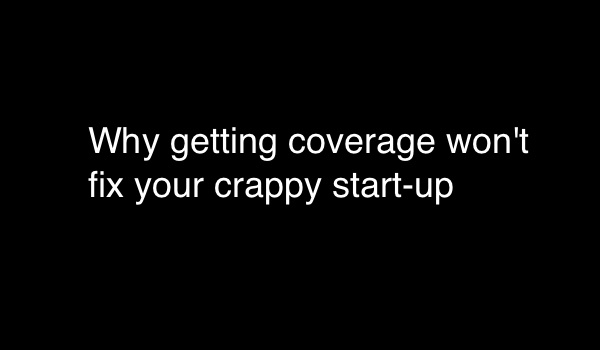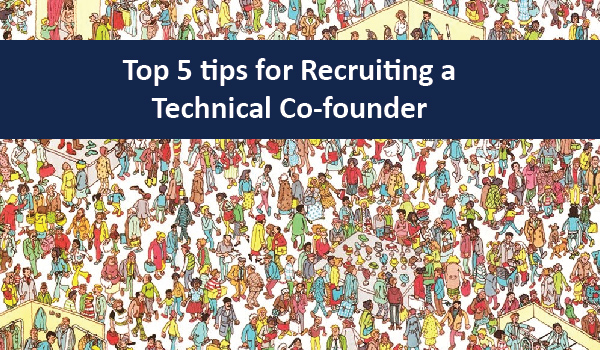30 days out from launch I was reflecting on the top things I need to do to help make my company as successful as possible. Here were the top 5 things 1. MVP, MVP, MVP – This isn’t the time to get fancy with all the bells and whistles. You can always build them later. This is about making sure your system works. The question here should be “Is the baseline user experience working?”. I have been tempted to ask for this, that and the other. At the end of the day, the system needs to work in its purest form. 2. You are the Quality Assurance and the product manager – Testing is never a fun activity, but guess what? It is your responsibility to go out and test every freaking button, every square pixel of your user experience. IT IS YOUR RESPONSIBILITY TO FIND ALL OF THE BUGS! 3. Focus and inspire your team – As the fearless leader of your team, it is your job to keep everyone pumped and excited and firing on all cylinders. It is easy for everyone to get distracted with background noise. Whether it be showing up with pizza while everyone works into the night, or passing on an encouraging word to someone who is really rocking it, it is your job to help everyone stay on their A game. 4. Prime the pump – Work with your perspective partners and customers ahead of time. If you haven’t done this yet, this is the time you want to start speaking to them. You want to hit the starting line with a running start not with a dead stop. This will rapidly help and ensure you will get moving faster. 5. Ask for help – You are only one person. Although you may be running yourself ragged to be all things to all people internally and externally, you need to not be afraid of asking for help. Friends, family or colleagues (assuming that you haven’t pissed them off) are generally more than willing to help you. Make sure you keep track and get ready to thank those people when you achieve what you set out to do. More times than not, people can forget or not be appreciative to all the people that helped them along the...
Read MoreLately, I have had the opportunity to sit across the table for a coffee or a beer with a lot of technically talented people. Some of them I have actively recruit into Printchomp, because I recognize their skillset and ability and what they bring to the table. I have however seen some irritating trends. So people may be working on their pet project, which is totally fine, but then as an after thought they wonder how can I get millions of people to using it. This point leads me to my general hypothesis: that there are two equally important parts to balance the equation, the business part and technical part. I just sat in on a MBA class of students pitching their company ideas, and one resounding thing came back time and again. Many spent the presentation talking about a cool new technology, but not the pain it was solving. This is how I feel sometimes when I am listening to pure technologists describe their product to me. Yes it might be technically excellent but why the hell would I want to use it? There are some interesting lean principles regarding validation and testing hypotheses that can help pure technical people avoid those traps. That said I don’t think enough technical folks test those assumptions. It really comes back to why are you building this feature or product. One of the other judges at this university pitch presentation hit the nail on the head, build what you can sell not sell what you can build. I will go to my final point. There is a lack of respect for marketing and business development. Converting people to using your service or product doesn’t “just happen”. There are some instances where things can strike a nerve and go bonkers, but the vast majority of things need to build an audience. Audiences are built using good messaging and tactics, executed by a person who knows what they are doing. If you are an engineer and approach a friend to help you with marketing, don’t expect that they will impart all their knowledge in 10 minutes. Imagine your disgust if they expected you to tell them all about development in 10 minutes, it ain’t gonna happen. People need to consider tough questions like Cost Per Acquisition (CPA). They also have to know whether it is even worth it to acquire that customer, if you don’t have a downstream strategy, what is the point. One company in the pitch competition was stating their key differentiator to Dropbox was unlimited storage. I went on to painfully explain how one user could effectively break their business...
Read MoreWarning! This doesn’t apply to everyone who has tried to pitch me a story, but enough for me to write this blog post. Please don’t jump all over my head thinking that I am referring to you. When I started off as a part-time rogue blogger, I found it easy to write on things I found interesting. As the regularity and velocity of my blogging picked up, I found an interesting trend emerge. I now get a regular steady beat of requests to write about their start-up or a weird obscure thing going on in their company. Now don’t get me wrong,I come across a few real gems and legitimately interesting things going on. However, I drill down a bit further on why many of these companies are so actively seeking coverage (especially the ones that I find a bit dubious) and have found an alarming, but not surprising trend. Many of these companies are using coverage to mask the fact that their company has significant holes in it. It could be that their business is a “me too” company or that they are not nearly as far along as they claim to be, or even that the number of active users they have on their system just isn’t really interesting. Let me set the record straight: as a marketer, going after coverage is a perfectly acceptable and smart way to help advance the goals of your start-up. I am in the process of launching my own start-up right now (Printchomp – shameless plug alert) and PR will be a corner stone of driving user sign-ups and interest in the company. That said, if you are no where close to achieving product-market fit, your User Experience absolutely sucks or you’re a shameless knockoff of another site, maybe you don’t want to be pushing so hard for coverage. Even if all those items are fixed, you also have to make sure you have a compelling reason to actively pursue coverage. A veiled excuse to get backlinks from a major tech blog isn’t enough in my opinion. So before you send out an article request to piss off yet another tech journalist, ask yourself a key question. If you receive coverage, will it materially fix any of the day to day problems your start-up faces? It is like using wallpaper for structural support in a building. It looks nice, but it won’t keep your house from falling...
Read MoreFor the last 2 months, I have had my head down building the first start-up in which I was one of the founders. While I spent time coming up with the idea, figuring out how to make money with it, and deciding what it would do, I knew that I needed technical expertise. I started to spend time searching for a technical co-founder, because it is one of the most crucial hires that a new start-up needs. Here are some tips that I have compiled after spending time in search. 1. Run your search in parallel with all other activities – The search for a good technical co-founder can take weeks or months. Don’t try to get a bunch of other tasks done first before you begin your search. The best recommendation I can give is to run the processes in parallel. It will not only save you time, but you might get some fantastic advice along the way to help you further refine your idea. Also if the first person you find isn’t the right person, you might get some leads from them to send you in the right direction. 2. Know what skills you possess and vice versa – Mapping skills and deficiencies of you and your potential co-founder is essential. There is nothing worse than not admitting where your strong and weak traits lie. Do yourself a favor – be upfront with them and encourage them to be upfront with you. What this will do is foster trust and remove any ugly surprises later on in the process. There is nothing worse than assuming on either side you are good at everything. Once you have an idea what you both do well and what you suck at, you can begin to start mapping out additional hires or contractors to fill those potential holes. If you map everything out and find there are some pretty glaring holes, you have to take a long look in the mirror and figure out whether both sides are bringing enough to the table. 3. Skills don’t always equal a good technical co-founder – The person might have the skills that pay the bills, but does that mean they are a good technical co-founder? I would say definitely not. Beyond having the technical acumen to get you to MVP, does that person have the temperament to grow and scale a business? How would they react to a massive changes? When you hit a bump in the road, are they going to rise to the challenge or run for the hills? As much as they need the ability to write lines of code, their ability...
Read MoreWrestleMania has transformed itself from a small wrestling event to an international media spectacle. In its 28th incarnation, held at the beginning of this month, there were no signs of it stopping. The WWE did something unique last year – it announced the main event for Wrestlemania over a year in advance. The big match featured Dwayne “The Rock” Johnson, a huge cross-over star, and John Cena, the current flag bearer for the company. Recognizing the challenges of trying to keep interest for the match a year in advance, the WWE turned to social media. I wanted to some of the people driving this initiative, both on- and off-screen. Jason Hoch, SVP of Digital Operations for the WWE, discussed his social media strategies for fan engagement and social TV. Since joining the WWE, Hoch undertook a huge project to re-launch WWE.com with a totally new UX with social media at its core. Rather than just putting as Jason says “plug-ins” or social areas, they have tried to build the entire site to be socially enabled. This included deep integration so users could follow their favorite stars on multiple social networks and interact with them seamlessly. Throughout the event, WrestleMania and related hashtags dominated Twitter. As they push hard into social, Jason specifically recognizes that social media fatigue is a key element that needs to be closely monitored to determine what level of interaction is appropriate and doesn’t turn off fans in its broadcasts and other media. I also interviewed Zack Ryder, who talked about how he has elevated his career due to social media. Zack has been one of the key individuals who helped push social onto the WWE radar and elevate its corporate importance. While he isn’t the biggest star in the WWE, his usage of social has elevated his position in the company and allowed him to better engage his fans. He points to this and says if he didn’t embrace social media and make some waves he would have likely been fired. This is a good example of how employees are using social media to elevate their status within a company and make themselves more valuable employees in the eyes of their employers. So far, their engagement strategy appears to be working. The WWE feels like they are more up-to-date and engaged. In many cases, WWE wrestlers were actively retweeted, followed and engaged by fans. One stat that is very telling was the number of followers and likes they have on Facebook and Twitter. The numbers behind this are impressive. Between all of the stars’ accounts, they have over 60 million Twitter followers and 20 million Facebook...
Read MoreIt’s the eve of WrestleMania 28, and I got a chance to meet with Dwayne “The Rock” Johnson. What does that have to do with tech? Well, in the video interview, Johnson shares his thoughts on how social media has changed the game, what is his favorite tech and how he uses it to engage his fans. Johnson says he launched his Twitter account a little more than a year ago, and that it’s “one of the greatest things” he’s ever done, because it gives him a way to connect directly to fans. “A lot of people would have had a team coming in … these great business minds, but I wanted to strip away the business of it all,” he says. You can see more, including a peek at Johnson’s iPhone, in the video above. (The background noise is a little loud at first, but Johnson comes through loud and...
Read More




